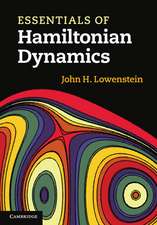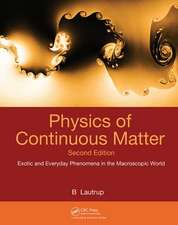Jacobi Dynamics: A Unified Theory with Applications to Geophysics, Celestial Mechanics, Astrophysics and Cosmology: Astrophysics and Space Science Library, cartea 369
Autor V.I. Ferronsky, S.A. Denisik, S.V. Ferronskyen Limba Engleză Hardback – 11 apr 2011
The main dynamical effects which become understandable by that solution can be summarized as follows:
• the kinetic energy of oscillation of the interacting particles which explains the physical meaning and nature of the gravitation forces;
• separation of the shell’s rotation of a self-gravitating body with respect to the mass density;
difference in angular velocities of the shell rotation;
• continuity in changing the potential of the outer gravitational force field together with changes in density distribution of the interacting masses (volumetric center of masses);
• the nature of the precession of the Earth, the Moon and satellites; the nature of the rotating body’s magnetic field and the generation of the planet’s electromagnetic field.
As a final result, the creation of the bodies in the Solar System having different orbits was discussed. This result is based on the discovery that all the averaged orbital velocities of the bodies in the Solar System and the Sun itself are equalto the first cosmic velocities of their proto-parents during the evolution of their redistributed mass density.
Audience
The work is a logical continuation of the book Jacobi Dynamics and is intended for researchers, teachers and students engaged in theoretical and experimental research in various branches of astronomy (astrophysics, celestial mechanics and stellar dynamics and radiophysics), geophysics (physics and dynamics of the Earth’s body, atmosphere and oceans), planetology and cosmogony, and for students of celestial, statistical, quantum and relativistic mechanics and hydrodynamics.
| Toate formatele și edițiile | Preț | Express |
|---|---|---|
| Paperback (2) | 1110.09 lei 6-8 săpt. | |
| SPRINGER NETHERLANDS – 29 mai 2013 | 1110.09 lei 6-8 săpt. | |
| SPRINGER NETHERLANDS – 27 sep 2011 | 1221.07 lei 6-8 săpt. | |
| Hardback (2) | 1116.26 lei 6-8 săpt. | |
| SPRINGER NETHERLANDS – 11 apr 2011 | 1116.26 lei 6-8 săpt. | |
| SPRINGER NETHERLANDS – 31 dec 1986 | 1228.62 lei 6-8 săpt. |
Din seria Astrophysics and Space Science Library
- 24%
 Preț: 799.08 lei
Preț: 799.08 lei - 15%
 Preț: 647.92 lei
Preț: 647.92 lei - 18%
 Preț: 983.81 lei
Preț: 983.81 lei - 18%
 Preț: 790.28 lei
Preț: 790.28 lei -
 Preț: 359.85 lei
Preț: 359.85 lei -
 Preț: 389.70 lei
Preț: 389.70 lei - 20%
 Preț: 691.13 lei
Preț: 691.13 lei - 18%
 Preț: 1011.27 lei
Preț: 1011.27 lei -
 Preț: 402.56 lei
Preț: 402.56 lei - 15%
 Preț: 664.93 lei
Preț: 664.93 lei -
 Preț: 398.15 lei
Preț: 398.15 lei - 18%
 Preț: 954.77 lei
Preț: 954.77 lei -
 Preț: 411.04 lei
Preț: 411.04 lei - 18%
 Preț: 1225.31 lei
Preț: 1225.31 lei - 18%
 Preț: 1843.29 lei
Preț: 1843.29 lei -
 Preț: 393.13 lei
Preț: 393.13 lei -
 Preț: 400.26 lei
Preț: 400.26 lei - 18%
 Preț: 953.82 lei
Preț: 953.82 lei - 18%
 Preț: 960.61 lei
Preț: 960.61 lei -
 Preț: 398.35 lei
Preț: 398.35 lei -
 Preț: 390.84 lei
Preț: 390.84 lei -
 Preț: 413.76 lei
Preț: 413.76 lei -
 Preț: 416.64 lei
Preț: 416.64 lei - 18%
 Preț: 947.67 lei
Preț: 947.67 lei -
 Preț: 404.51 lei
Preț: 404.51 lei - 18%
 Preț: 956.50 lei
Preț: 956.50 lei -
 Preț: 403.75 lei
Preț: 403.75 lei - 18%
 Preț: 1229.40 lei
Preț: 1229.40 lei - 18%
 Preț: 1224.99 lei
Preț: 1224.99 lei -
 Preț: 404.29 lei
Preț: 404.29 lei - 15%
 Preț: 654.77 lei
Preț: 654.77 lei - 18%
 Preț: 1248.20 lei
Preț: 1248.20 lei - 18%
 Preț: 955.25 lei
Preț: 955.25 lei - 18%
 Preț: 1846.28 lei
Preț: 1846.28 lei - 18%
 Preț: 1233.06 lei
Preț: 1233.06 lei - 18%
 Preț: 1234.77 lei
Preț: 1234.77 lei -
 Preț: 411.64 lei
Preț: 411.64 lei
Preț: 1116.26 lei
Preț vechi: 1361.28 lei
-18% Nou
Puncte Express: 1674
Preț estimativ în valută:
213.62€ • 220.68$ • 177.79£
213.62€ • 220.68$ • 177.79£
Carte tipărită la comandă
Livrare economică 26 martie-09 aprilie
Preluare comenzi: 021 569.72.76
Specificații
ISBN-13: 9789400704978
ISBN-10: 9400704976
Pagini: 344
Ilustrații: XIV, 330 p.
Dimensiuni: 155 x 235 x 25 mm
Greutate: 0.66 kg
Ediția:2nd ed. 2011
Editura: SPRINGER NETHERLANDS
Colecția Springer
Seria Astrophysics and Space Science Library
Locul publicării:Dordrecht, Netherlands
ISBN-10: 9400704976
Pagini: 344
Ilustrații: XIV, 330 p.
Dimensiuni: 155 x 235 x 25 mm
Greutate: 0.66 kg
Ediția:2nd ed. 2011
Editura: SPRINGER NETHERLANDS
Colecția Springer
Seria Astrophysics and Space Science Library
Locul publicării:Dordrecht, Netherlands
Public țintă
ResearchCuprins
Preface to the Second Edition
Preface to the First Edition
1 Introduction: General Principles and Approaches in Dynamics
2 Recent Observations and Understanding Physical Meaning of Jacobi’s Virial Equation
3 Derivation of Jacobi’s Virial Equation for Description of Dynamics of Natural Systems
4 Solution of Jacobi’s Virial Equation for Conservative Systems
5 Perturbed Virial Oscillations of a System
6 Relationship Between Jacobi Function and Potential Energy
7 Applications in Celestial Mechanics and Geodynamics
8 Creation and Evolution of the Solar System Bodies
9 The Nature of Electromagnetic Field of a Celestial Body and Mechanism of Its Energy Generation
Conclusions
References
Subject Index
Preface to the First Edition
1 Introduction: General Principles and Approaches in Dynamics
2 Recent Observations and Understanding Physical Meaning of Jacobi’s Virial Equation
3 Derivation of Jacobi’s Virial Equation for Description of Dynamics of Natural Systems
4 Solution of Jacobi’s Virial Equation for Conservative Systems
5 Perturbed Virial Oscillations of a System
6 Relationship Between Jacobi Function and Potential Energy
7 Applications in Celestial Mechanics and Geodynamics
8 Creation and Evolution of the Solar System Bodies
9 The Nature of Electromagnetic Field of a Celestial Body and Mechanism of Its Energy Generation
Conclusions
References
Subject Index
Textul de pe ultima copertă
In their approach to Earth dynamics the authors consider the fundamentals of Jacobi Dynamics (1987, Reidel) for two reasons. First, because satellite observations have proved that the Earth does not stay in hydrostatic equilibrium, which is the physical basis of today’s treatment of geodynamics. And secondly, because satellite data have revealed a relationship between gravitational moments and the potential of the Earth’s outer force field (potential energy), which is the basis of Jacobi Dynamics. This has also enabled the authors to come back to the derivation of the classical virial theorem and, after introducing the volumetric forces and moments, to obtain a generalized virial theorem in the form of Jacobi’s equation. Thus a physical explanation and rigorous solution was found for the famous Jacobi’s equation, where the measure of the matter interaction is the energy.
The main dynamical effects which become understandable by that solution can be summarized as follows:
• the kinetic energy of oscillation of the interacting particles which explains the physical meaning and nature of the gravitation forces;
• separation of the shell’s rotation of a self-gravitating body with respect to the mass density;
difference in angular velocities of the shell rotation;
• continuity in changing the potential of the outer gravitational force field together with changes in density distribution of the interacting masses (volumetric center of masses);
• the nature of the precession of the Earth, the Moon and satellites; the nature of the rotating body’s magnetic field and the generation of the planet’s electromagnetic field.
As a final result, the creation of the bodies in the Solar System having different orbits was discussed. This result is based on the discovery that all the averaged orbital velocities of the bodies in the Solar System and the Sun itself are equalto the first cosmic velocities of their proto-parents during the evolution of their redistributed mass density.
Audience
The work is a logical continuation of the book Jacobi Dynamics and is intended for researchers, teachers and students engaged in theoretical and experimental research in various branches of astronomy (astrophysics, celestial mechanics and stellar dynamics and radiophysics), geophysics (physics and dynamics of the Earth’s body, atmosphere and oceans), planetology and cosmogony, and for students of celestial, statistical, quantum and relativistic mechanics and hydrodynamics.
The main dynamical effects which become understandable by that solution can be summarized as follows:
• the kinetic energy of oscillation of the interacting particles which explains the physical meaning and nature of the gravitation forces;
• separation of the shell’s rotation of a self-gravitating body with respect to the mass density;
difference in angular velocities of the shell rotation;
• continuity in changing the potential of the outer gravitational force field together with changes in density distribution of the interacting masses (volumetric center of masses);
• the nature of the precession of the Earth, the Moon and satellites; the nature of the rotating body’s magnetic field and the generation of the planet’s electromagnetic field.
As a final result, the creation of the bodies in the Solar System having different orbits was discussed. This result is based on the discovery that all the averaged orbital velocities of the bodies in the Solar System and the Sun itself are equalto the first cosmic velocities of their proto-parents during the evolution of their redistributed mass density.
Audience
The work is a logical continuation of the book Jacobi Dynamics and is intended for researchers, teachers and students engaged in theoretical and experimental research in various branches of astronomy (astrophysics, celestial mechanics and stellar dynamics and radiophysics), geophysics (physics and dynamics of the Earth’s body, atmosphere and oceans), planetology and cosmogony, and for students of celestial, statistical, quantum and relativistic mechanics and hydrodynamics.
Caracteristici
A theoretical treatise on a unified theory with applications to the dynamics of the Earth, Moon, planets and satellites, the Sun and the stars Builds up fundamentals of real dynamics of the Earth Written by experts in the field Includes supplementary material: sn.pub/extras
Recenzii
`It is stimulating and resourceful reading for the astronomer, geophycist, or for any physically oriented scientists who sees his research subject placed within the framework of global natural systems.'
Space Science Reviews, Vol. 47, No. 204, 1988.
Space Science Reviews, Vol. 47, No. 204, 1988.


















